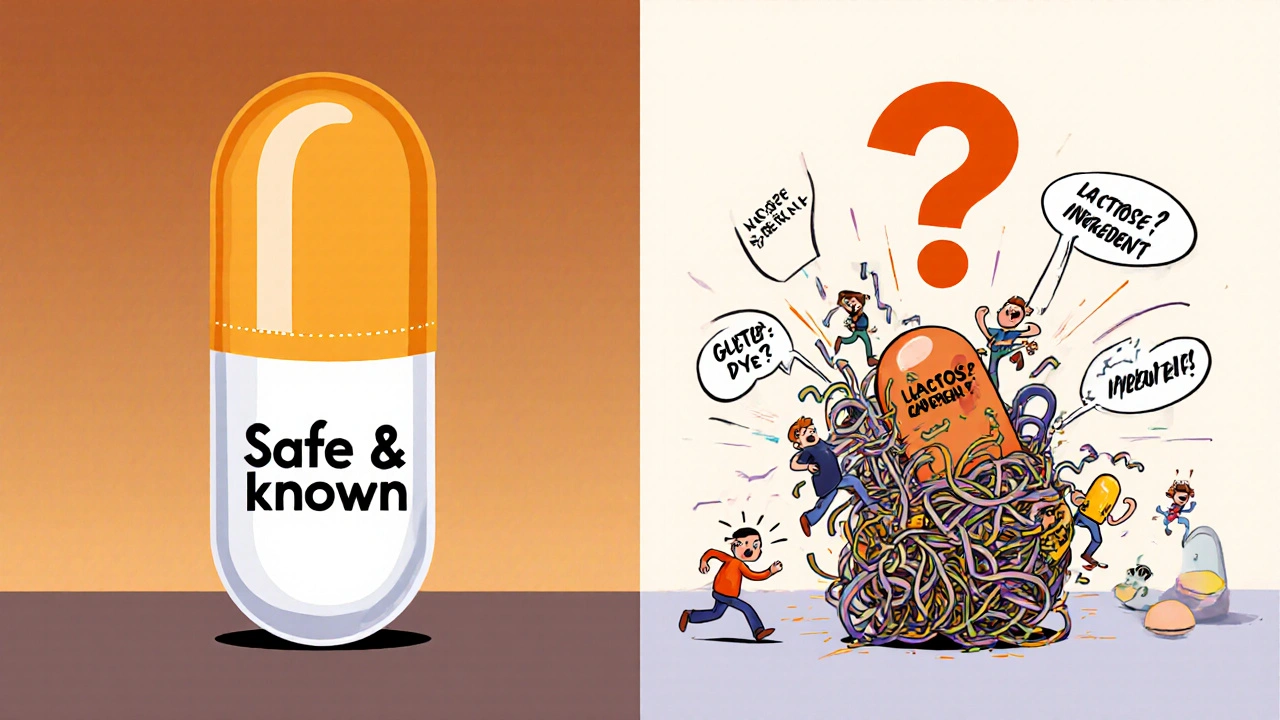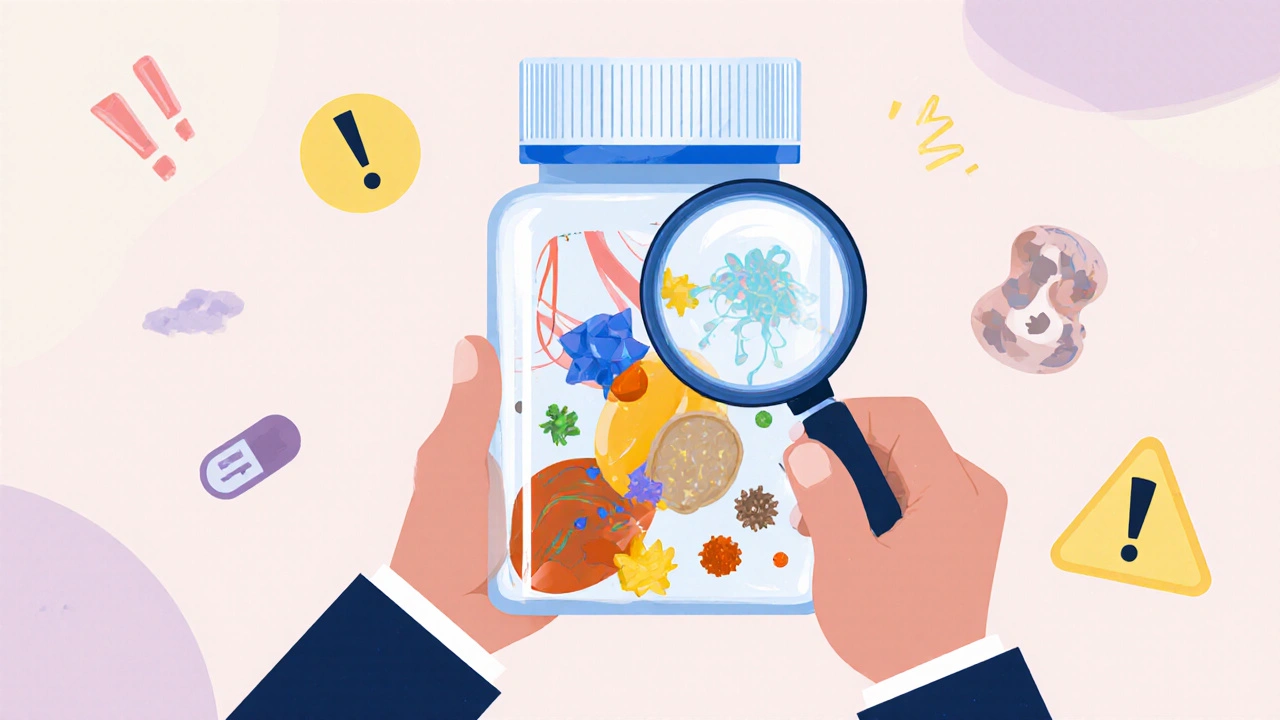Most people assume that if a generic pill looks different from the brand-name version, it’s just a cheaper copy of the same thing. But what if the difference isn’t just in price or color - what if it’s in the stuff you can’t see? The truth is, inactive ingredients in generic medications can make a real difference - especially if you’re sensitive to them.
What Are Inactive Ingredients?
Inactive ingredients, also called excipients, are the non-drug parts of a pill. They don’t treat your condition. But they do everything else: hold the pill together, help it dissolve in your stomach, make it taste better, or keep it from falling apart on the shelf. In some pills, more than half the weight comes from these ingredients. In rare cases, up to 99% of the pill is inactive material.Think of it like baking a cake. The flour, sugar, and eggs are the active ingredients - they give you the flavor and energy. But the baking powder, vanilla extract, and food coloring? Those are the inactive ingredients. They’re necessary for the cake to work, but you wouldn’t eat them if you were allergic to one of them.
Generic drugs must have the same active ingredient as the brand-name version. That’s the law. But they can - and often do - use completely different inactive ingredients. That’s where problems can start.
Why Do Generic Drugs Have Different Fillers?
Generic manufacturers don’t have to copy the brand’s recipe. They just need to prove their version delivers the same amount of active drug into your bloodstream at a similar rate. That’s called bioequivalence. It doesn’t require matching the fillers, binders, dyes, or preservatives.Why does this matter? Because different companies use different suppliers, different processes, and different cost-cutting tricks. One generic version of levothyroxine might use cornstarch. Another might use lactose. A third might use a dye that triggers skin rashes in sensitive people.
And here’s the kicker: there’s no federal requirement to label these ingredients as allergens unless they’re one of the big eight (like peanuts or shellfish). Lactose? Gluten? FODMAP sugars? Dyes like Red 40? These can be in your pill - and you won’t know unless you dig deep into the manufacturer’s documentation.
What Inactive Ingredients Cause Problems?
Not everyone reacts. But for those who do, the symptoms can be real and disruptive:- Lactose - Found in about 20% of all oral medications. Can cause bloating, cramps, and diarrhea in people with lactose intolerance.
- Gluten - Used as a binder in some pills. Even tiny amounts can trigger reactions in people with celiac disease.
- FODMAP sugars (like lactose, fructose, sorbitol) - Present in about 55% of medications. Can worsen IBS symptoms.
- Bisulfites (like sodium metabisulfite) - Used as preservatives. Can trigger asthma attacks in sensitive individuals.
- Food dyes (Red 40, Yellow 5, Blue 1) - Used for appearance. Linked to skin rashes, headaches, and hyperactivity in some people.
- Peanut oil - Rare, but still used in some liquid medications. Always labeled, but only if it’s a direct allergen.
MIT and Brigham and Women’s Hospital found that nearly all medications contain at least one ingredient that some patients can’t tolerate. And with 90% of prescriptions in the U.S. filled with generics, that’s a lot of people taking pills with unknown fillers.

Real Stories: When Switching Generics Backfired
It’s not theoretical. People report problems all the time.One patient on Reddit switched from Synthroid (brand-name levothyroxine) to a generic version and developed severe stomach cramps. The symptoms vanished the moment she switched back. Another person with chronic migraines started getting daily headaches after switching to a generic version of topiramate. Her neurologist suspected a dye in the pill - and when she switched to a different generic with a different color, the headaches stopped.
A 2022 survey by MedShadow found that 27% of people who switched to generic medications reported new side effects. Of those, 68% blamed the inactive ingredients. The FDA’s own adverse event database has hundreds of reports tied to fillers - though proving direct cause is hard because most systems don’t track the specific version of the drug.
Even more concerning: studies on blood pressure drugs showed a spike in adverse events after generics hit the market. Losartan cases went up 8%, valsartan 12%, and candesartan 14%. Experts still debate whether it was the fillers, the manufacturing process, or something else. But the pattern is there.
Are Generic Drugs Safe?
Yes - for most people. The FDA requires generics to meet the same quality, strength, and purity standards as brand-name drugs. The active ingredient is identical. The bioequivalence testing is strict. For the average person taking one or two meds, generics are safe and cost-effective.But safety isn’t the same as suitability. If you have allergies, intolerances, or chronic conditions like IBS, celiac disease, or asthma, the differences in fillers matter. You’re not being paranoid. You’re being careful.
Dr. Giovanni Traverso, who led the MIT study on inactive ingredients, put it simply: “Doctors have no idea which of these ingredients will be included in the pills they prescribe to their patients.”

What Should You Do?
You don’t need to avoid generics. But you do need to be smart about them.- Know your triggers. If you’re allergic to lactose, gluten, or dyes, keep a list. Write it down. Keep it in your phone.
- Ask your pharmacist. When you get a new generic prescription, ask: “What are the inactive ingredients?” Pharmacists have access to the full drug profile - including the exact fillers used in that batch.
- Check the manufacturer. The FDA’s Inactive Ingredient Database lists approved ingredients, but it’s hard to read. Look up the drug name + “inactive ingredients” + the manufacturer’s name. Their website often has a patient info sheet.
- Don’t switch generics randomly. If you’re stable on one generic brand, don’t switch to another unless your pharmacist tells you it’s the same formulation. Even different batches from the same company can change fillers.
- Speak up if something changes. If you start feeling worse after switching to a generic - bloating, rash, fatigue, headaches - tell your doctor. Don’t assume it’s “just in your head.”
- Ask for a brand if needed. If you’ve had a reaction, your doctor can write “dispense as written” or “no substitutions” on your prescription. Insurance might push back, but many will cover the brand if you have documented sensitivity.
The Bigger Picture
This isn’t just about one pill. It’s about polypharmacy. People over 65 take an average of five medications daily. That’s five different sets of fillers. Five different chances for a reaction. And right now, there’s no system tracking which combinations might interact in harmful ways.MIT researchers are building a public database to map inactive ingredients across all FDA-approved drugs. That’s a start. But until then, the burden falls on you.
The system works for most people. But if you’re one of the ones who reacts - whether it’s a mild stomach upset or a full-blown allergic response - you’re not alone. And you’re not overreacting. You’re navigating a system that doesn’t yet see you.
Generic drugs save billions every year. That’s huge. But saving money shouldn’t mean sacrificing safety for those who need it most. The goal isn’t to scare you off generics. It’s to help you use them wisely - and speak up when something doesn’t feel right.
Are generic medications as effective as brand-name drugs?
Yes, for the active ingredient. Generic drugs must prove they deliver the same amount of medicine into your bloodstream at the same rate as the brand-name version. This is called bioequivalence. For most people, they work just as well. But if you have sensitivities to fillers, you might notice differences in side effects, even if the drug itself works the same.
Can inactive ingredients cause allergic reactions?
Yes. While rare, ingredients like lactose, gluten, bisulfites, and food dyes can trigger reactions in sensitive people. Symptoms range from stomach upset and skin rashes to asthma attacks. Most drug labels don’t warn about these unless they’re major allergens like peanuts. You have to ask your pharmacist or check the manufacturer’s documentation.
How do I find out what’s in my generic medication?
Ask your pharmacist for the “inactive ingredients” list. You can also search online using the drug name, manufacturer, and the phrase “inactive ingredients.” The FDA’s Inactive Ingredient Database exists but isn’t user-friendly. Some manufacturers post patient information sheets on their websites. If you’re unsure, request the package insert that comes with the pill bottle.
Should I avoid generic medications if I have food allergies?
Not necessarily. But you should be extra cautious. If you’re allergic to gluten, lactose, or certain dyes, check every new generic prescription. Some manufacturers make “hypoallergenic” versions without common fillers. Your pharmacist can help you find them. Don’t assume a generic is safe just because it’s cheaper.
Can I request a brand-name drug instead of a generic?
Yes. Your doctor can write “dispense as written” or “no substitutions” on your prescription. Insurance may require prior authorization, especially if you’ve had documented side effects from a generic version. Many insurers will approve the brand if you can show a clear reaction to the generic.
Why don’t drug labels list all inactive ingredients clearly?
Current FDA rules only require labeling of major allergens (like peanuts) and a few other high-risk ingredients. Most fillers - including gluten, lactose, and FODMAP sugars - don’t require warning labels. This is a gap in transparency. Advocacy groups are pushing for better labeling, but changes are slow. Until then, you need to ask.


